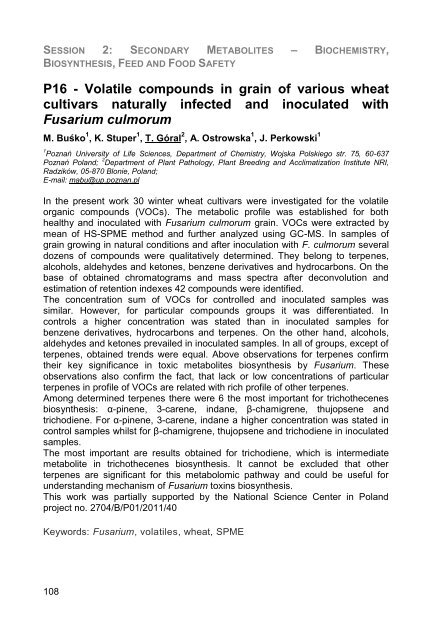EFS12- Book of abstracts - Contact
EFS12- Book of abstracts - Contact
EFS12- Book of abstracts - Contact
You also want an ePaper? Increase the reach of your titles
YUMPU automatically turns print PDFs into web optimized ePapers that Google loves.
SESSION 2: SECONDARY METABOLITES – BIOCHEMISTRY,<br />
BIOSYNTHESIS, FEED AND FOOD SAFETY<br />
P16 - Volatile compounds in grain <strong>of</strong> various wheat<br />
cultivars naturally infected and inoculated with<br />
Fusarium culmorum<br />
M. Buśko 1 , K. Stuper 1 , T. Góral 2 , A. Ostrowska 1 , J. Perkowski 1<br />
1 Poznań University <strong>of</strong> Life Sciences, Department <strong>of</strong> Chemistry, Wojska Polskiego str. 75, 60-637<br />
Poznań Poland; 2 Department <strong>of</strong> Plant Pathology, Plant Breeding and Acclimatization Institute NRI,<br />
Radzików, 05-870 Blonie, Poland;<br />
E-mail: mabu@up.poznan.pl<br />
In the present work 30 winter wheat cultivars were investigated for the volatile<br />
organic compounds (VOCs). The metabolic pr<strong>of</strong>ile was established for both<br />
healthy and inoculated with Fusarium culmorum grain. VOCs were extracted by<br />
mean <strong>of</strong> HS-SPME method and further analyzed using GC-MS. In samples <strong>of</strong><br />
grain growing in natural conditions and after inoculation with F. culmorum several<br />
dozens <strong>of</strong> compounds were qualitatively determined. They belong to terpenes,<br />
alcohols, aldehydes and ketones, benzene derivatives and hydrocarbons. On the<br />
base <strong>of</strong> obtained chromatograms and mass spectra after deconvolution and<br />
estimation <strong>of</strong> retention indexes 42 compounds were identified.<br />
The concentration sum <strong>of</strong> VOCs for controlled and inoculated samples was<br />
similar. However, for particular compounds groups it was differentiated. In<br />
controls a higher concentration was stated than in inoculated samples for<br />
benzene derivatives, hydrocarbons and terpenes. On the other hand, alcohols,<br />
aldehydes and ketones prevailed in inoculated samples. In all <strong>of</strong> groups, except <strong>of</strong><br />
terpenes, obtained trends were equal. Above observations for terpenes confirm<br />
their key significance in toxic metabolites biosynthesis by Fusarium. These<br />
observations also confirm the fact, that lack or low concentrations <strong>of</strong> particular<br />
terpenes in pr<strong>of</strong>ile <strong>of</strong> VOCs are related with rich pr<strong>of</strong>ile <strong>of</strong> other terpenes.<br />
Among determined terpenes there were 6 the most important for trichothecenes<br />
biosynthesis: α-pinene, 3-carene, indane, β-chamigrene, thujopsene and<br />
trichodiene. For α-pinene, 3-carene, indane a higher concentration was stated in<br />
control samples whilst for β-chamigrene, thujopsene and trichodiene in inoculated<br />
samples.<br />
The most important are results obtained for trichodiene, which is intermediate<br />
metabolite in trichothecenes biosynthesis. It cannot be excluded that other<br />
terpenes are significant for this metabolomic pathway and could be useful for<br />
understanding mechanism <strong>of</strong> Fusarium toxins biosynthesis.<br />
This work was partially supported by the National Science Center in Poland<br />
project no. 2704/B/P01/2011/40<br />
Keywords: Fusarium, volatiles, wheat, SPME<br />
108
















![Présentation CRB-anim [Mode de compatibilité] - Inra](https://img.yumpu.com/17418636/1/190x135/presentation-crb-anim-mode-de-compatibilite-inra.jpg?quality=85)